« October 2007 | Main | August 2007 »
Sunday 30 September 2007
Italian Festival
About a hundred years ago, they tell us, the Highlands area around Bardstown and Eastern Parkway was host to a thriving Italian community. Their heritage lives on at the annual Festa Italiana there, which we attended today.
We got there early, so we had to sit around a awhile before the food was ready and the music started, but it was worth the wait (and not only because we got in free for being early).
 This duo was pretty darn good. They could sing a variety of Italian
music from medieval ballads to opera to "The Best is Yet to Come."
This duo was pretty darn good. They could sing a variety of Italian
music from medieval ballads to opera to "The Best is Yet to Come."
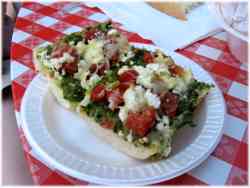 The foccacia was great, and only a dollar a chunk!
The foccacia was great, and only a dollar a chunk!
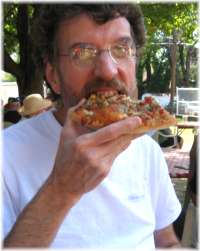 And yeah, I know that the Italians didn't invent pizza, but how can you
go to an Italian festival and not have any pizza?
And yeah, I know that the Italians didn't invent pizza, but how can you
go to an Italian festival and not have any pizza?
Saturday 29 September 2007
Herd of Balloons
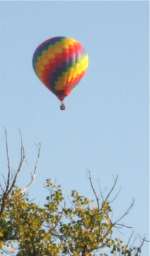 This weekend, about a hundred balloons gather in Louisville for a
festival. I saw the mass takeoff yesterday on my way to work, but
unfortunately did not have my camera with me (and I call myself a
blogger! Hmpf!).
This weekend, about a hundred balloons gather in Louisville for a
festival. I saw the mass takeoff yesterday on my way to work, but
unfortunately did not have my camera with me (and I call myself a
blogger! Hmpf!).
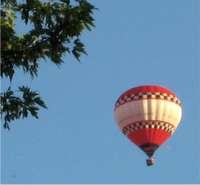 Today they flew over the house, and I did get a few shots. I'm still
looking for "Chuggles", the balloon that is supposedly shaped like a cow.
Today they flew over the house, and I did get a few shots. I'm still
looking for "Chuggles", the balloon that is supposedly shaped like a cow.
Friday 21 September 2007
Need some Plutonium-239?
For that really special science fair project?
Oak Ridge National Laboratories has some for sale. Note "Quantity discounts may be available"!
Just don't call me if the FBI knocks on your door after clicking on that link.
Sunday 16 September 2007
Ft Harrod and Beaumont Inn
 Today we had a great visit to Fort
Harrod State Park. The park sits in the middle of Harrodsburg, and
contains a museum, a reconstruction of the old fort, a cemetery, and the
chapel where Lincoln's parents were married. Quite hunk of Kentucky
history crammed into a city block.
Today we had a great visit to Fort
Harrod State Park. The park sits in the middle of Harrodsburg, and
contains a museum, a reconstruction of the old fort, a cemetery, and the
chapel where Lincoln's parents were married. Quite hunk of Kentucky
history crammed into a city block.
Fort Harrod was the first or second permanent European settlement west of the Alleghenies. In 1774 Captain Harrod and 32 rather determined men left Pennsylvania down the Ohio River and set up Fort Harrod here. The year before, in 1773, Daniel Boone was bringing a group of settlers over the Cumberland Gap to establish a town when they were attacked by Indians. Boone's son and several settlers were killed in the attack; the rest lost their nerve and retreated back down the Gap. Boone returned with more settlers in 1775, establishing a fort in Madison County, and eventually founding Boonesboro. This would seem to suggest that Harrod gets credit for the first white settlement, but the Boone supporters still claim Boone's fort was first, and I haven't studied the controversy enough yet to inject an informed opinion.
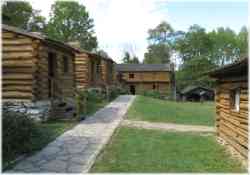 There are costumed interpreters in the various buildings at Fort Harrod,
and you can discuss aspects of early pioneer life with them. I had a
great talk about Gen. George Rogers Clark with the guy who knew all
about him and his guide, and another discussion about early iron tools
with one of the craftsmen there. They have a large collection of very
rare original period iron tools at the fort.
There are costumed interpreters in the various buildings at Fort Harrod,
and you can discuss aspects of early pioneer life with them. I had a
great talk about Gen. George Rogers Clark with the guy who knew all
about him and his guide, and another discussion about early iron tools
with one of the craftsmen there. They have a large collection of very
rare original period iron tools at the fort.
We learned about Ann Kennedy Wilson Poague Lindsay McGinty, who crossed the Cumberland Gap carrying her spinning wheel on her horse. There was no flax in those days, so she spun wild nettle. This was okay for making cloth, but it was an unpleasing dull grey color. So she figured out how to dye it using local barks and nutshells. Then she taught her husband how to construct wheels and looms and soon she had all the women spinning, dyeing, and weaving. She outlived four husbands; I guess she could cook, too.
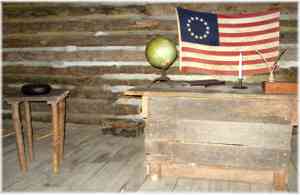 I visited the replica of General Clark's blockhouse and this office
where he planned his conquest of the Northwest Territory. There were
several other cabins to visit, including a school room with an original
dunce stool.
I visited the replica of General Clark's blockhouse and this office
where he planned his conquest of the Northwest Territory. There were
several other cabins to visit, including a school room with an original
dunce stool.
 The original cemetery contains over four hundred graves in a very small
place; the early graves are topped with unmarked stones. All in all, a
great place to visit, although CVH though it was a bit of a "boy's
place".
The original cemetery contains over four hundred graves in a very small
place; the early graves are topped with unmarked stones. All in all, a
great place to visit, although CVH though it was a bit of a "boy's
place".
After we left the fort we had lunch at the Beaumont Inn, originally constructed in 1845 as a girl's school and now operated as an inn by the same family since 1917. It's a very popular brunch spot with the locals, but they managed to squeeze us in, even though we didn't have reservations. They have rhubarb pie for dessert!
Boone Tavern in Berea
We spent last night at Boone Tavern in Berea. Berea is primarily known for two things: it is the biggest artist community in Kentucky, and it is home to Berea College. What makes Berea College interesting is that it implemented certain Christian principles way ahead of its time. It was the first coed, integrated college in the South – founded in the eighteen-fifties with a gift of land from Cassius Clay. As you might imagine, they've had their difficulties over the years, especially when intergrated education was outlawed in the early twentieth century.
It wasn't exactly wildly popular in the eighteen-fifties, either, and they found that, lacking financial backers, the students had to do most of the work putting the college together. So even today, the college serves primarily underprivileged kids from Appalachia; it's tuition-free, but every student works part-time somewhere on campus.
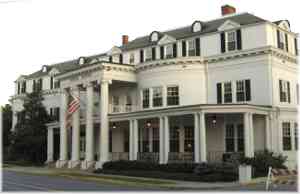 In this picture of the Boone Tavern, you may notice the road barrier in
the lower right. They’d blocked off the road there because they’d
brought in Zydeco Bon to play for a street dance. If you’re a regular
reader of this blog (?), you may recall that I mentioned Zydeco Bon at
the Cherokee Triangle Festival on 29 April 2007. I was so tired from
driving up and down the mountains that I didn’t dance very long, but I
still maintain that they could hold their own against all but a few of
the bands in Lafayette, and could even be the main act at Mulate’s on
weekdays.
In this picture of the Boone Tavern, you may notice the road barrier in
the lower right. They’d blocked off the road there because they’d
brought in Zydeco Bon to play for a street dance. If you’re a regular
reader of this blog (?), you may recall that I mentioned Zydeco Bon at
the Cherokee Triangle Festival on 29 April 2007. I was so tired from
driving up and down the mountains that I didn’t dance very long, but I
still maintain that they could hold their own against all but a few of
the bands in Lafayette, and could even be the main act at Mulate’s on
weekdays.
The story behind the founding of the Tavern was that in the early days of the college, it was customary for guests to be put up at the president's house. After over three hundred guests came the summer of 1908, the president's wife suggested that it was time for the college to build an inn for guests, and this was done that very next year.
Much of the furniture in the hotel was made by the students. It's a very pleasant place to stay. There's even a student-staffed pizzeria around the corner, and they make pizza that tasted just like the pizza I remember from college.
Saturday 15 September 2007
The Cumberland Gap and the Wilderness Road
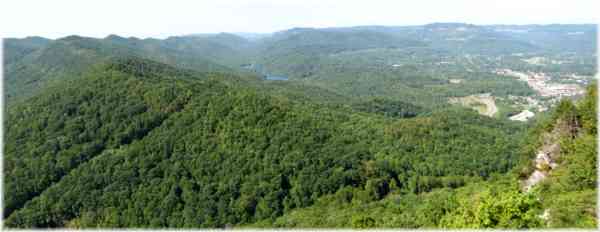
The Cumberland Gap
Coming back to Kentucky, we drove through the Cumberland Gap. For those of you who have not done this in the last ten years or so, you don’t drive over the Gap, but rather you go through the mountain in a nice modern tunnel. The old road has been restored to a hiking trail so that you can cross the Gap as the original settlers did. We didn’t have the time to hike the trail, but we were able to drive up to the top of the mountain on the Virginia side and look down at the Gap. It’s a more impressive sight than you might imagine. In this photo, you're looking down onto the Gap from Virginia. The Gap is that gash running from the bottom center of the picture to the right. The tunnel runs through the mountain right behind it. It was a beautiful day, but there were a lot of twisty mountain roads to cover to get where I could take this photo.
We had lunch at Pine Mountain state park, the last of the passes you go through to get across the Appalachians into Kentucky. But the park is on top of the mountain, so up and down another twisty road.
Driving along the route of the old Wilderness Road, the route of the first settlers, we came to Levi Jackson Wilderness Road Historical State Park. They had some simple exhibits and reconstructed buildings demonstrating how people lived here in the late eighteenth century. The park is also the site of a massacre that occurred in 1786 when a group of settlers inadvertantly set up camp on top of a hill that the local Indians considered sacred. When the Indians witnessed the settlers staying up late playing cards and partying on their sacred ground, they lost it. Most of the settlers were killed, twenty-eight scalped, and several taken as prisoner. One of the survirors got a preacher to come back and help bury the dead. They interred the bodies in a mass grave, the location of which you can visit, but the grave itself was desecrated long ago by souvenir hunters (ugh).
Friday 14 September 2007
Smoky Mountains National Park
Today we visited Great Smoky Mountains National Park. It was raining, so we didn’t get a chance to do any real hiking and the pictures aren’t so good. The mists and fog that come off the mountains in odd shapes really do look like smoke rising from the trees.
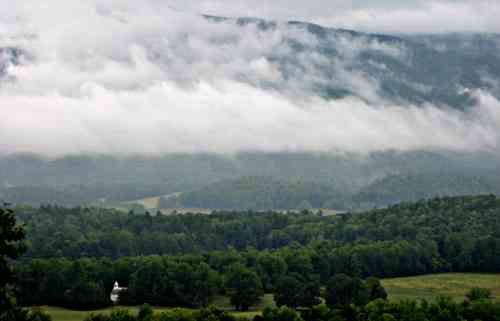
In this photo you can see some of the smoke and one of the churches that remain from when people lived up in where the park is now. They don’t say much about what happened to those people after the park was dedicated.
This park is the most-visited National Park in the country; the Grand Canyon is number two, and it gets about half as many visitors. This means that the park is rather crowded. Even though we visited on a rainy Friday morning in the middle of September (after school had started, but before the leaves started to turn), traffic through the town of Pigeon Forge going to the park was bumper to bumper, and there was a lot of traffic inside the park. We couldn’t begin to imagine what this park would be like on a summer weekend. After a couple of hours, we were finally able to escape the traffic by turning off on a narrow, twisty dirt road that switchbacked right up the side of the mountain and down the other. We did not see any bears.
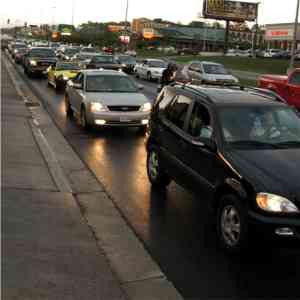
Traffic approaching the park
You should be aware that the area on the Tennessee side of the park consists of several miles of dense traffic, slowly moving past a great number of motels, all-you-can-eat restaurants, “musical shows” that resemble Chuck-E-Cheese on steroids, uncountable time-share & rental outfits, and retail outlets of every stripe. If you are expecting a pleasant drive out into the woods to do some quiet hiking, you will likely be disappointed.
Thursday 13 September 2007
Cumberland Falls
Today we went to Cumberland Falls State Park and saw one of the largest waterfalls east of the Mississippi. The Cumberland River is quite low this year due to the drought, so the falls weren’t quite as impressive as they usually are. Nonetheless, they are a beautiful site to see – CVH describes it as “picture postcard” views. Old-fashioned beauty.
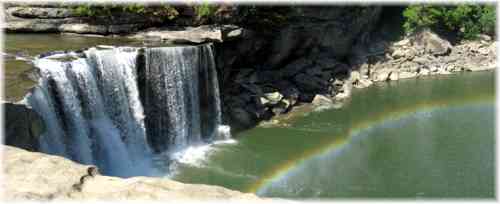
In this photo you can see the rainbow produced by the waterfall’s mist.
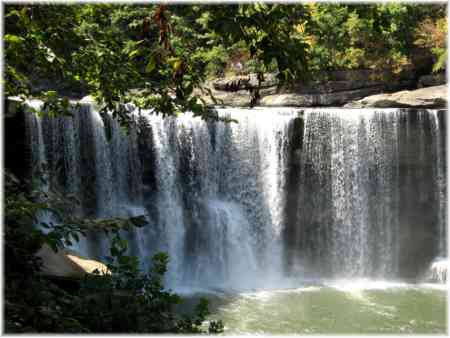
Here’s a closer look at the falls. They are quite noisy. The first (white) explorers discovered them as they came down the Cumberland River about 1780. They heard the noise in time to jump and swim ashore; fortunately, their boat survived the leap over the falls, and they were able to recover it.
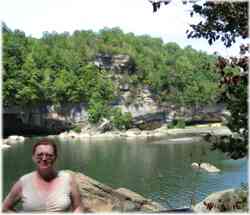
CVH in front of Cumberland River
We hiked along the river for a short while, climbing a few hundred old steps; this park is a lovely place. At one point on the trail we came across a park ranger laboriously scraping the graffiti off the rocks where teenagers had scratched their names. He was not happy about this. He said he’d like to catch who had done this so that they could be sentenced to some community service in the park, as he could sure use the help. CVH liked the “white noise” produced by the waterfall, but it quickly started to get on my nerves. During the ‘20s, there was a hotel perched right over the river; every room had a balcony that looked out over the falls. Despite being a four-hour mule-pulled ride from the nearest road, it was apparently quite popular, although I don’t know how anyone got any sleep with all that racket. On the way out, we visited the current park hotel, which is well away from the falls, but has a nice high view of the river below. There are also a large number of bird feeders on the back of the hotel, attracting a wide variety of birds just outside the hotel windows.
Sunday 09 September 2007
The Mayor's Labor Day Bicycle Ride
I first met the Mayor of Louisville, Jerry Abramson, at last year's Labor Day bicycle ride downtown. I had stopped at the halfway point, and saw him standing around, looking rather out of sorts, I guess because there wasn't anybody around speaking to him. He's been Mayor for over twenty years, and I recognized him because his face is on the billboards that you see when you get off the plane at the Louisville airport (this doesn't seem to be a problem here; I don't understand why it was one for Mr Brown in Houston). In any event, I introduced myself and shook his hand, and thanked him for organizing such a bicycle ride.
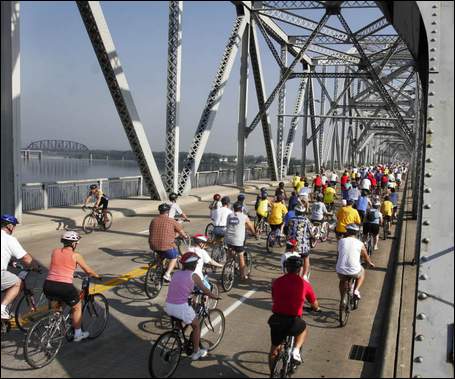 This Labor Day ride attracted over four thousand bicycle riders, but I
have to use that term loosely. Clearly, many of these people had no idea
how to ride a bicycle on public roads, and as consequence, the ride was
more of a stress test for me than a recreational ride.
This Labor Day ride attracted over four thousand bicycle riders, but I
have to use that term loosely. Clearly, many of these people had no idea
how to ride a bicycle on public roads, and as consequence, the ride was
more of a stress test for me than a recreational ride.
Saturday 01 September 2007
WorldFest
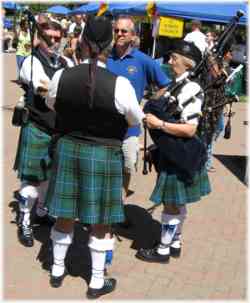
 Worldfest is Louisville's annual celebration of international cultures
in Louisville, and there are more than you might think. The Mayor's
office says eighty different languages are spoken in the schools. There
are about a hundred different booths setup, and the organizations run
from L'Alliance Francaise de Louisville and the Ancient Order of
Hibernians to the United Nations Association and the Save Darfur people.
The ethnic organizations show off their costumes, music, and food,
although we went primarily for the food (you can get reliably authentic
Mexican food there).
Worldfest is Louisville's annual celebration of international cultures
in Louisville, and there are more than you might think. The Mayor's
office says eighty different languages are spoken in the schools. There
are about a hundred different booths setup, and the organizations run
from L'Alliance Francaise de Louisville and the Ancient Order of
Hibernians to the United Nations Association and the Save Darfur people.
The ethnic organizations show off their costumes, music, and food,
although we went primarily for the food (you can get reliably authentic
Mexican food there).
Although most every white person you meet in Louisville grew up in Louisville, it seems, half of the recent newcomers to Louisville came from outside the United States, so the city is really starting to get an international flavor in spots around town and certainly at events like this.